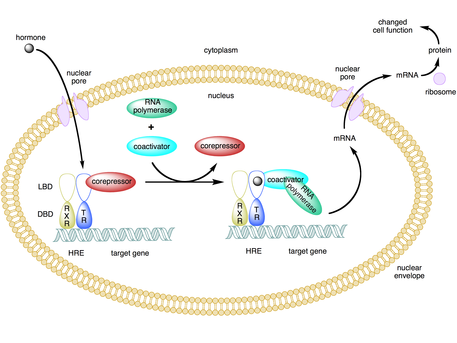
Back Coaktivator German Coactivador Spanish Coactivateur French Coactivador (xenética) Galician コアクチベーター Japanese Co-activator Dutch Коактиватор Russian

A coactivator is a type of transcriptional coregulator that binds to an activator (a transcription factor) to increase the rate of transcription of a gene or set of genes.[1] The activator contains a DNA binding domain that binds either to a DNA promoter site or a specific DNA regulatory sequence called an enhancer.[2][3] Binding of the activator-coactivator complex increases the speed of transcription by recruiting general transcription machinery to the promoter, therefore increasing gene expression.[3][4][5] The use of activators and coactivators allows for highly specific expression of certain genes depending on cell type and developmental stage.[2]
Some coactivators also have histone acetyltransferase (HAT) activity. HATs form large multiprotein complexes that weaken the association of histones to DNA by acetylating the N-terminal histone tail. This provides more space for the transcription machinery to bind to the promoter, therefore increasing gene expression.[1][4]
Activators are found in all living organisms, but coactivator proteins are typically only found in eukaryotes because they are more complex and require a more intricate mechanism for gene regulation.[1][4] In eukaryotes, coactivators are usually proteins that are localized in the nucleus.[1][6]
- ^ a b c d Courey AJ (2008). Mechanisms in transcriptional regulation. Malden, MA: Blackwell. ISBN 978-1-4051-0370-1. OCLC 173367793.
- ^ a b "General transcription factor / transcription factor". Learn Science at Scitable. Retrieved 2017-11-29.
- ^ a b Pennacchio LA, Bickmore W, Dean A, Nobrega MA, Bejerano G (April 2013). "Enhancers: five essential questions". Nature Reviews Genetics. 14 (4): 288–95. doi:10.1038/nrg3458. PMC 4445073. PMID 23503198.
- ^ a b c Brown CE, Lechner T, Howe L, Workman JL (January 2000). "The many HATs of transcription coactivators". Trends in Biochemical Sciences. 25 (1): 15–9. doi:10.1016/S0968-0004(99)01516-9. PMID 10637607.
- ^ Kumar R, O'Malley BW (2008). NR coregulators and human diseases. Hackensack, N.J.: World Scientific. ISBN 978-981-270-536-5. OCLC 261137374.
- ^ Vosnakis N, Koch M, Scheer E, Kessler P, Mély Y, Didier P, Tora L (September 2017). "Coactivators and general transcription factors have two distinct dynamic populations dependent on transcription". The EMBO Journal. 36 (18): 2710–2725. doi:10.15252/embj.201696035. PMC 5599802. PMID 28724529.
© MMXXIII Rich X Search. We shall prevail. All rights reserved. Rich X Search